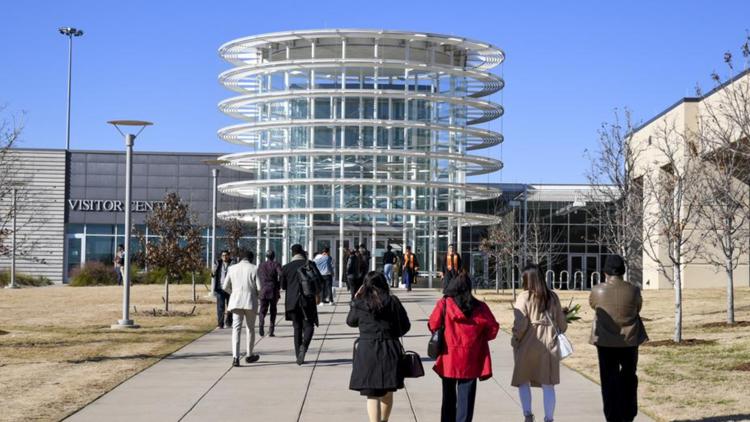DALLAS — Read this story and more North Texas business news from our partners at the Dallas Business Journal. See Correction/Clarification at the end of this article.
The University of Texas at Dallas had the highest average faculty pay among DFW colleges and universities last year, with full-time instructional staff earning $125,185 per year on average.
That’s according to a recent Business Journals analysis of fiscal year 2023 U.S. Department of Education data for public and private schools.
Southern Methodist University ranked second in DFW with an average salary of $124,476 for full-time instructional staff followed by Texas Christian University with an average of $119,378.
Rice University in Houston paid $158,388 on average to full-time instructional staff, making it the highest paying university in the state. The University of Texas at Austin was No. 2 with an average salary of $133,806.
Glenn Colby, senior researcher at the American Association of University Professors, said compensation in higher education is rebounding from pandemic pressures.
"For the first time since 2019, faculty salaries have outpaced inflation — just barely, by 2.4%," Colby said.
The rebound has been particularly pronounced among private schools, which had been hit the hardest by the pandemic.
"Public institutions seemed somewhat more insulated from effects," he said. "But private schools were more apt to enact hiring freezes and suspend retirement contributions."
Private school faculty are less likely to unionize, meaning cuts were often made in real time as opposed to when contracts came up for renewal.
State allocations are the greatest source of revenue for public universities, Colby said. For private universities, tuition is the greatest source of revenue.
In 2022-23, tuition and fees at SMU ran $61,980, making it the most expensive university in DFW, according to National Center for Education Statistics data analyzed by the Dallas Business Journal. TCU was No. 2 with tuition and fees of $53,980, and UT Dallas was No. 11 at $14,564 for in-state students. All three tout extensive scholarship opportunities.
Non-instructor pay growing fast
In 2023, the average overall salary among all full-time university and college employees — including non-instructional staff — was $69,238.
The highest overall employee average salaries were found at Stanford University ($135,771), followed by MiraCosta College ($129,743) in Oceanside, California and Franklin W. Olin College of Engineering ($120,086) in Needham, Massachusetts.
Drilling down to instructional employees, the national average was $82,235 in 2023, which was up 18% from $69,429 in 2013.
By comparison, national, public-sector wages grew more than 40% during that same span.
About 49% of university faculty positions are part-time, and up until recently those salaries were dropping as well, Colby said.
The highest salaries for full-time instructional staff were found at some of the nation’s most elite schools. California Institute of Technology posted an average of $239,790. Harvard University ($220,073) and Stanford University ($204,079) were close behind.
Meanwhile, non-instructional salaries increased 28% from $49,573 in 2013 to $63,403 by 2023. The highest averages were again found at Stanford University ($124,042), MiraCosta College ($122,892) and Franklin W. Olin College of Engineering ($119,508).
President-to-faculty pay ratio also on rise
Among the highest non-instruction wages are those paid to presidents, chief financial officers and key administrators.
Department of Education data reveals the average president-to-faculty pay ratio increased from 4.2 to 4.6 since 2020. That means presidents are paid 4.6 times the salary of a full-time doctoral faculty member on average.
In addition to seeing faster wage growth, non-instructional staff are seeing their ranks grow more swiftly.
"Institutions are creating more director and assistant director positions to oversee programs that were formerly under the purview of tenured faculty," Colby said.
"As colleges have grown, they’ve hired more contingent or part-time faculty who are not eligible for tenure. Then, the administration says, 'We don’t have enough (full-time) faculty to fill out the committees, therefore we’re going to create an assistant director position that will do work formerly done by faculty.'"
From 2013 to 2023, the University of Mississippi added 5,734 non-instructors. University of California-Los Angeles (5,423), Rutgers University (3,641) and Harvard University (2,936) all topped the list of schools that increased full-time, nonclassroom positions.
Future of college varies by region
Since 2014, enrollment at American universities has increased 9%.
While some schools continue to up their non-instructional numbers, an enrollment cliff looms.
Experts anticipate the nation’s most selective schools may see little to no effect. But smaller schools could be hit hard, especially in areas that have seen considerable out-migration during and after the pandemic.
"Regional universities in the Northeast, maybe in some parts of the Midwest, or small colleges that rely on students coming from nearby, need to be prepared for fewer students applying," Colby said.
Correction/Clarification: This story has been updated with the correct tuition and fees cost for the University of Texas at Dallas in 2022-23.



